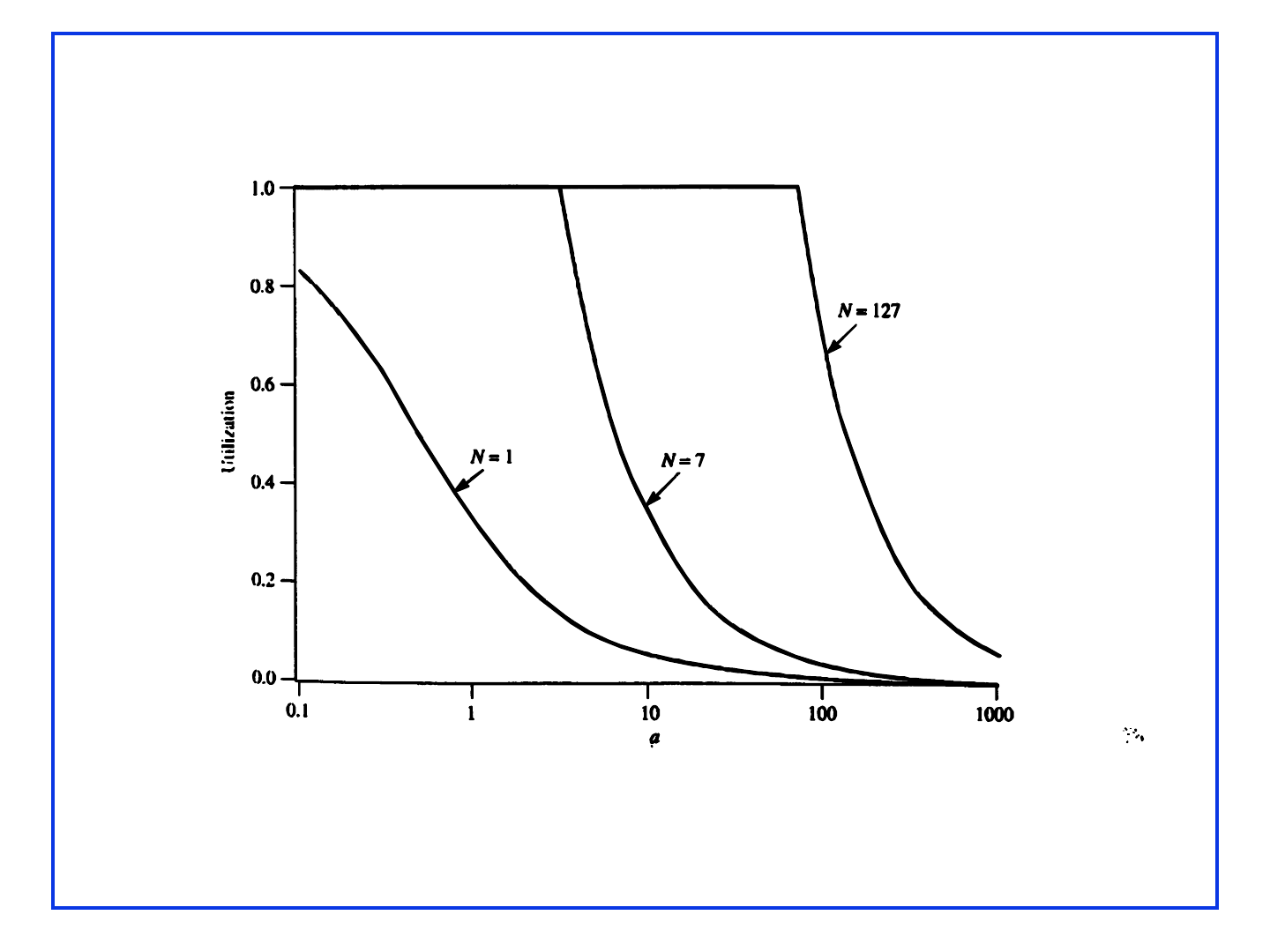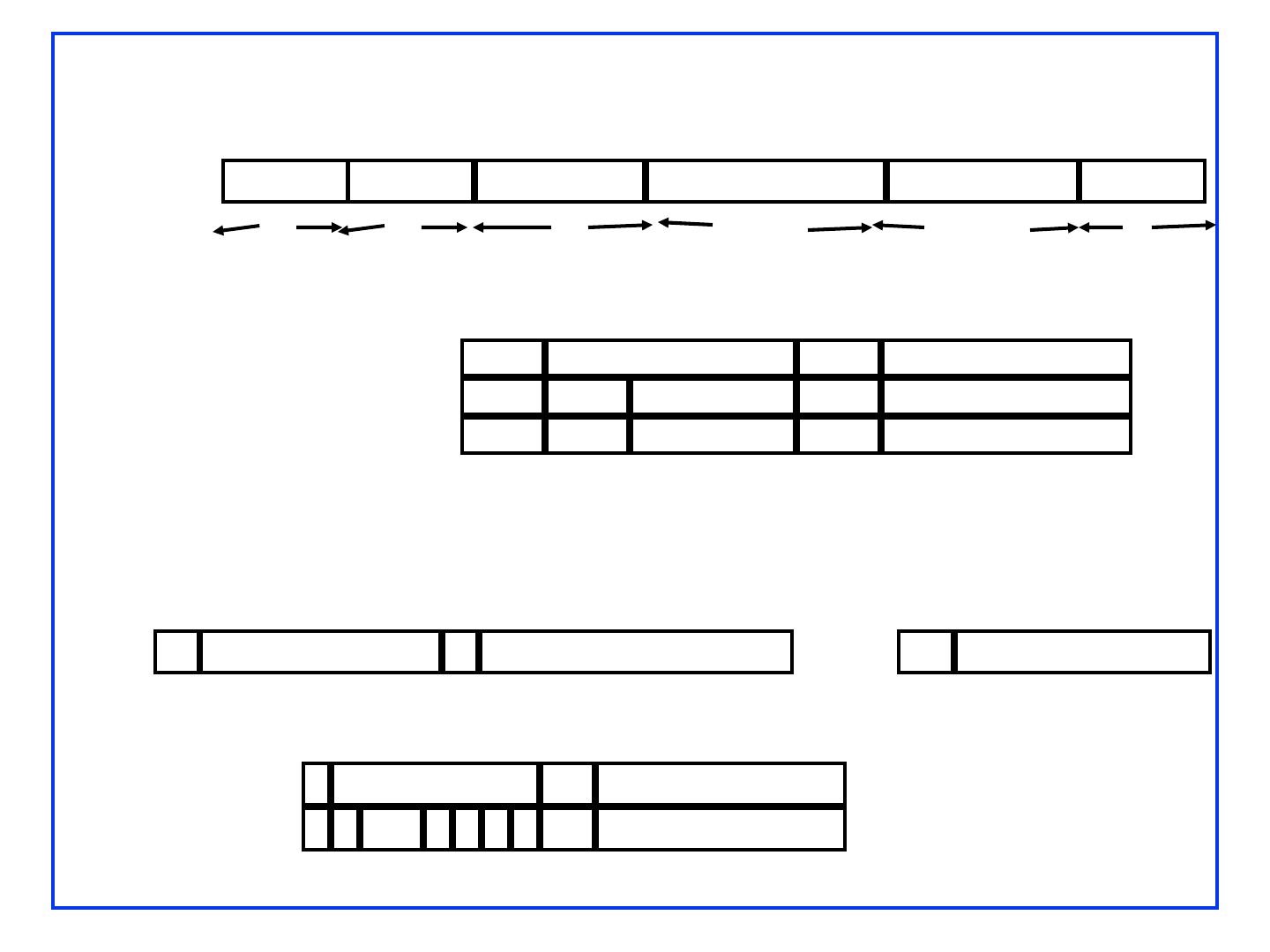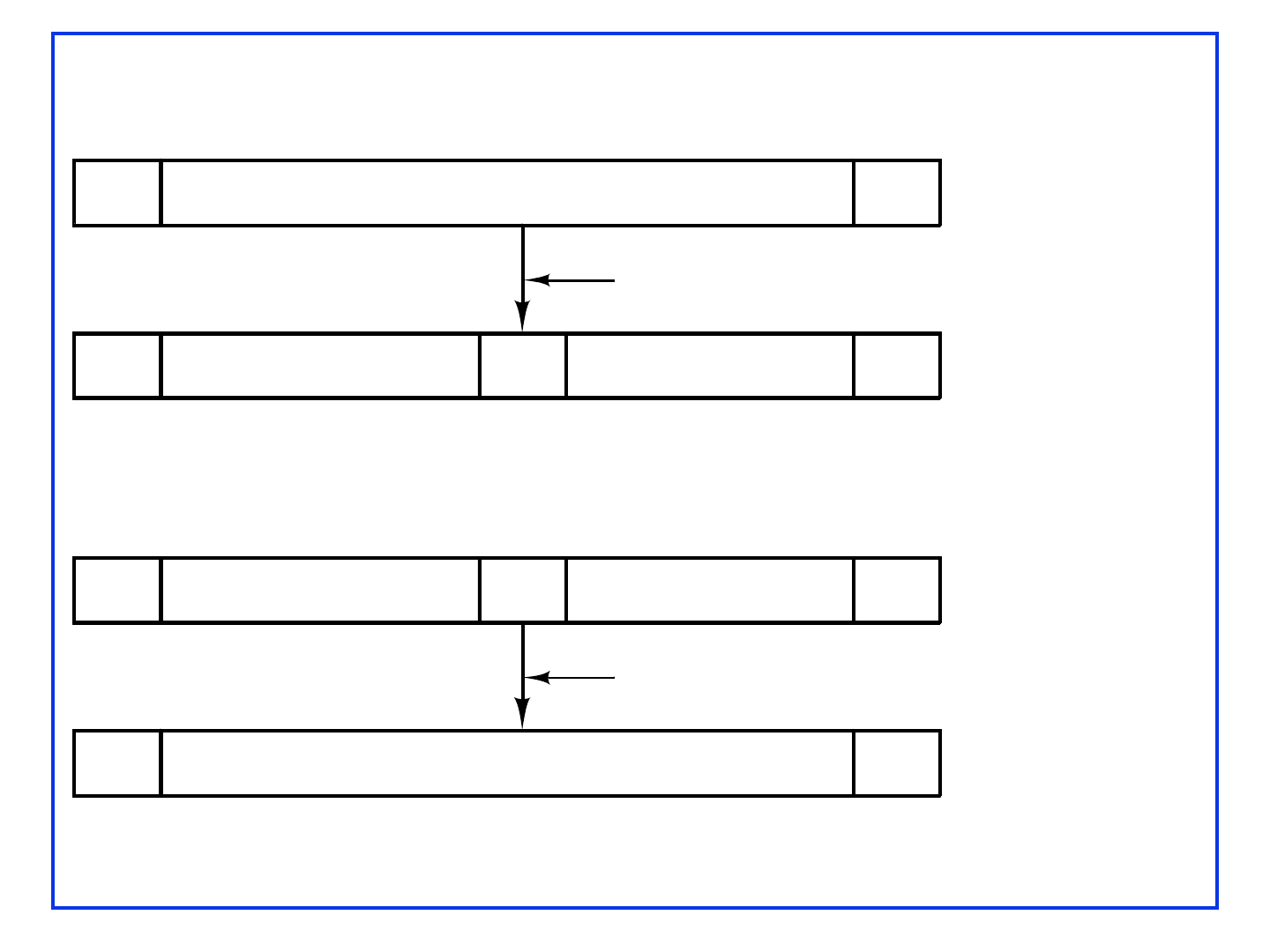
7-1
©2005 Raj JainCSE473sWashington University in St. Louis
Data Link Control
Data Link Control
Protocols
Protocols
Raj Jain
Washington University
Saint Louis, MO 63131
These slides are available on-line at:
http://www.cse.wustl.edu/~jain/cse473-05/

7-2
©2005 Raj JainCSE473sWashington University in St. Louis
Overview
Overview
q Flow Control
q Effect of propagation delay, speed, frame size
q Error Recovery
q HDLC

7-3
©2005 Raj JainCSE473sWashington University in St. Louis
Flow Control
Flow Control
q Flow Control Goals:
1. Sender does not flood the receiver,
2. Maximize throughput
q Sender throttled until receiver grants permission

7-4
©2005 Raj JainCSE473sWashington University in St. Louis
Space
Space
-
-
Time Diagrams
Time Diagrams
Space
Time

7-5
©2005 Raj JainCSE473sWashington University in St. Louis
Stop and Wait Flow Control
Stop and Wait Flow Control
Data
Ack
Ack
Data
t
frame
t
prop
=
1
2α + 1
U=
2t
prop
+t
frame
t
frame
α =
t
prop
t
frame
=
Distance/Speed of Signal
Bits Transmitted /Bit rate
=
Distance × Bit rate
Bits Transmitted × Speed of Signal
Light in vacuum
= 300 m/μs
Light in fiber
= 200 m/μs
Electricity
= 250 m/μs

7-6
©2005 Raj JainCSE473sWashington University in St. Louis
Utilization: Examples
Utilization: Examples
q Satellite Link: Propagation Delay t
prop
= 270 ms
Frame Size = 500 Bytes = 4 kb
Data rate = 56 kbps ⇒ t
frame
= 4/56 = 71 ms
α = t
prop
/t
frame
= 270/71 = 3.8
U = 1/(2α+1) = 0.12
q Short Link: 1 km = 5 μs,
Rate=10 Mbps,
Frame=500 bytes ⇒ t
frame
= 4k/10M= 400 μs
α=t
prop
/t
frame
=5/400=0.012 ⇒ U=1/(2α+1)=0.98
Note: The textbook uses B for t
prop
and L for t
frame

7-7
©2005 Raj JainCSE473sWashington University in St. Louis
Efficiency Principle
Efficiency Principle
q For all protocols, the maximum utilization (efficiency)
is a non-increasing function of α.
α
Max
Utilization
Not Possible
Protocol 1
Protocol 2
Best
possible
α =
t
prop
t
frame
=
Distance × Bit rate
Bits Transmitted ×Speed of Signal

7-8
©2005 Raj JainCSE473sWashington University in St. Louis
Sliding Window Protocols
Sliding Window Protocols
q Window = Set of sequence numbers to send/receive
q Sender window
q Sender window increases when ack received
q Packets in sender window must be buffered at
source

7-9
©2005 Raj JainCSE473sWashington University in St. Louis
Sliding Window Diagram
Sliding Window Diagram

7-10
©2005 Raj JainCSE473sWashington University in St. Louis
Sliding Window Example
Sliding Window Example

7-11
©2005 Raj JainCSE473sWashington University in St. Louis
Sliding Window Protocol Efficiency
Sliding Window Protocol Efficiency
Data
Ack
t
frame
t
prop
U=
W t
frame
2t
prop
+t
frame
=
W
2α+1
1 if W>2α+1

7-12
©2005 Raj JainCSE473sWashington University in St. Louis
Effect of Window Size
Effect of Window Size
α
U
q Larger window is better for larger α

7-13
©2005 Raj JainCSE473sWashington University in St. Louis
Piggybacking
Piggybacking
Data
Data+Ack
t
frame
t
prop
Header Ack Data
Header Data

7-14
©2005 Raj JainCSE473sWashington University in St. Louis
Error Control
Error Control
q Error Control = Deliver frames without error, in the proper
order to network layer
q Error control Mechanisms:
q Ack/Nack: Provide sender some feedback about other end
q Time-out: for the case when entire packet or ack is lost
q Sequence numbers: to distinguish retransmissions from
originals
Timeout

7-15
©2005 Raj JainCSE473sWashington University in St. Louis
Stop
Stop
-
-
and
and
-
-
Wait ARQ
Wait ARQ
Automatic
Repeat
reQuest
(ARQ)

7-16
©2005 Raj JainCSE473sWashington University in St. Louis
Go
Go
-
-
Back
Back
-
-
N ARQ
N ARQ
q Receiver does not cache out-of-order frames
q Sender has to go back and retransmit all frames after
the lost frame
RcvrSender
1
Nack 1
1
0
1
2
2
3
3

7-17
©2005 Raj JainCSE473sWashington University in St. Louis
Go
Go
-
-
back
back
-
-
N (Cont)
N (Cont)
All possible scenarios are handled:
1. Damaged Frame:
q Frame received with error
q Frame lost
q Last frame lost
2. Damaged Ack:
q One ack lost, next one makes it
q All acks lost
3. Damaged Nack:
q Maximum Window = 2
n
-1
with n-bit sequence numbers

7-18
©2005 Raj JainCSE473sWashington University in St. Louis
Selective Reject ARQ
Selective Reject ARQ
q Receiver caches out-of-order frames
q Sender retransmits only the lost frame
RcvrSender
1
Nack 1
1
0
1
2
4
3
5

7-19
©2005 Raj JainCSE473sWashington University in St. Louis
Selective Reject: Window Size
Selective Reject: Window Size
0
1
2
3
4
5
6
7
0
Ack
Sequence number space > 2 window size
Window size <
2
n-1
Timeout

7-20
©2005 Raj JainCSE473sWashington University in St. Louis
Performance: Maximum Utilization
Performance: Maximum Utilization
q Stop and Wait Flow Control: U = 1/(1+2α)
q Window Flow Control:
q Stop and Wait ARQ: U = (1-P)/(1+2α)
q Go-back-N ARQ:
q Selective Reject ARQ:
U =
1W>2α+1
W/(2α+1) W< 2α+1
{
U =
(1-P)/(1+2αP) W> 2α+1
W(1-P)/[(2α+1)(1-P+wP)] W< 2α+1
{
U =
(1-P) W> 2α+1
W(1-P)/(2α+1) W< 2α+1
{

7-21
©2005 Raj JainCSE473sWashington University in St. Louis
Performance Comparison
Performance Comparison
1.0
0.8
0.6
0.4
0.2
0.0
0.1 1 10 100 1000
α
Utilization
Stop-and-wait
W= 127 Go-back-N
W=7 Go-back-N &
W= 7 Selective-reject
W= 127 Selective-reject
More bps or longer distance

7-22
©2005 Raj JainCSE473sWashington University in St. Louis
HDLC Family
HDLC Family
q Synchronous Data Link Control (SDLC): IBM
q High-Level Data Link Control (HDLC): ISO
q Link Access Procedure-Balanced (LAPB): X.25
q Link Access Procedure for the D channel (LAPD): ISDN
q Link Access Procedure for modems (LAPM): V.42
q Link Access Procedure for half-duplex links (LAPX): Teletex
q Point-to-Point Protocol (PPP): Internet
q Logical Link Control (LLC): IEEE
q Advanced Data Communications Control Procedures (ADCCP): ANSI
q V.120 and Frame relay also use HDLC

7-23
©2005 Raj JainCSE473sWashington University in St. Louis
q Primary station: Issue commands
q Secondary Station:Issue responses
q Combined Station: Both primary and secondary
q Unbalanced Configuration: One or more secondary
q Balanced Configuration: Two combined station
q Normal Response Mode (NRM): Response from secondary
q Asynchronous Balanced Mode (ABM): Combined Station
q Asynchronous Response Mode (ARM): Secondary may respond before
command
HDLC
HDLC

7-24
©2005 Raj JainCSE473sWashington University in St. Louis
HDLC Frame Structure
HDLC Frame Structure
Frame
Format
Control Field Format
Extended Address Field
Extended Control Field
......
0 N(S) P/F N(R)
1 2 3 4 5 6 7 8 9 10 11 12 13 14 15 16
1 2 3 4 5 6 7 8 9 10 11 12 13 14 15 16
1 2 3 4 5 6 7 8
1 0 S 0 0 0 0 P/F N(R)
Information
Supervisory
N(S)= Send sequence number N(R)= Receive sequence number
S= Supervisory function bits M= Unnumbered bits P/F= Poll/final bit
I: Information
S: Supervisory
U: Unnumbered
8
8
8n 16 or 32 8
Address Control INFORMATION FCS FLAG
Extendable Extendable
0 N(S) P/F N(R)
1 0 S P/F N(R)
1 1 M P/F M
0
0
1
8n
Flag
8
bits

7-25
©2005 Raj JainCSE473sWashington University in St. Louis
111111111111011111101111110
After bit-stuffing
1111101111101101111101011111010
Bit Stuffing
Bit Stuffing
q HDLC Flag = 01111110
q Every where else in the frame:
Replace 11111 with 111110
Original Pattern

7-26
©2005 Raj JainCSE473sWashington University in St. Louis
(b) An inverted bit splits a frame in two
Transmitted
(c) An inverted bit merges two frames
Transmitted
Bit inverted
Bit inverted
Flag
Flag
Flag
Flag
Flag Flag
Flag
Flag
FlagFlag
Received
Received
Bit Stuffing (Cont)
Bit Stuffing (Cont)

7-27
©2005 Raj JainCSE473sWashington University in St. Louis
HDLC Frames
HDLC Frames
q Information Frames: User data
q Piggybacked Acks: Next frame expected
q Poll/Final = Command/Response
q Supervisory Frames: Flow and error control
q Go back N and Selective Reject
q Final ⇒ No more data to send
q Unnumbered Frames: Control
q Mode setting commands and responses
q Information transfer commands and responses
q Recovery commands and responses
q Miscellaneous commands and responses

7-28
©2005 Raj JainCSE473sWashington University in St. Louis
HDLC Commands and Responses
HDLC Commands and Responses
Name
Information (I)
Supervisory (S)
Receive Ready (RR)
Receive Not Ready (RNR)
Reject (REJ)
Selective Reject (SREJ)
Unnumbered (U)
Set Normal Response /
Extended Mode (SNRM / SNRME)
Set Asynchronous Response /
Extended Mode (SARM / SARME)
Set Asynchronous Balanced /
Extended Mode (SABM / SABME)
Set Initialization Mode (SIM)
Function
C/R
C/R
C/R
C/R
C/R
C
C
C
C
Description
Exchange user data
Positive Acknowledgement; ready
to receive I-frame
Positive acknowledgement; not
ready to receive
Negative acknowledgement; go
back N
Negative acknowledgement;
selective reject
Set mode;extended=two-octet control
field
Set mode;extended=two-octet control
field
Set mode;extended=two-octet control
field
Initialize link control functions in
addressed station

7-29
©2005 Raj JainCSE473sWashington University in St. Louis
HDLC Commands and Responses (cont)
HDLC Commands and Responses (cont)
Name Function Description
Disconnect (DISC)
Unnumbered Acknowledgement (UA)
Disconnect Mode (DM)
Request Disconnect (RD)
Request Initialization Mode (RIM)
Unnumbered Information (UI)
Unnumbered Poll (UP)
Reset (RSET)
Exchange Identification (XID)
Test (TEST)
Frame Reject (FRMR)
C
R
R
R
R
C/R
C
C
C/R
C/R
R
Terminate logical link connection
Acknowledges acceptance of one of the
above set-mode commands
Secondary is logically disconnected
Request for DISC command
Initialization needed; request for SIM
command
Used to exchange control information
Used to solicit control information
Used for recovery; resets N(R), N(S)
Used to request/report identity and
status
Exchange identical information fields
for testing
Reports receipt of unacceptable frame

7-30
©2005 Raj JainCSE473sWashington University in St. Louis
Examples of HDLC Operation
Examples of HDLC Operation
SABM
SABM
UA
DISC
UA
I,0,0
I,0,1
I,1,1
I,2,1
I,1,3
I,3,2
I,2,4
I,3,4
RR,4
I,3,0
RNR,4
RR,0,P
RNR,4,F
RR,0,P
RR,4,F
I,4,0
Timeout
(a) Link setup and
disconnect
(b) Two-way data
exchange
(c) Busy condition

7-31
©2005 Raj JainCSE473sWashington University in St. Louis
Examples of Operation (Cont)
Examples of Operation (Cont)
I,3,0
I,4,0
I,5,0
Rej, 4
I,4,0
I,5,0
I,6,0
I,2,0
RR,3
I,3,0
RR,0,P
RR,3,F
I,3,0
RR,4
(d) Reject Recovery (e) Timeout Recovery
*
*
Timeout

7-32
©2005 Raj JainCSE473sWashington University in St. Louis
Summary
Summary
q Flow Control: Stop and Wait, Sliding window
q Effect of propagation delay, speed, frame size
q Piggybacking
q Error Control: Stop and wait ARQ, Go-back-N, Selective
Reject
q HDLC: Primary and secondary stations, NRM, ABM, ARM
q HDLC Frames: Flag, Bit stuffing, I-Frame, RR, RNR

7-33
©2005 Raj JainCSE473sWashington University in St. Louis
Reading Assignment
Reading Assignment
q Read Chapter 7 and Appendix 7A of 7
th
edition of
Stallings.
q Do the following Exercise from the textbook:
7.8 (maximum link utilizations)
q There is no need to submit the answers.
Next Monday is the first mid-term.
